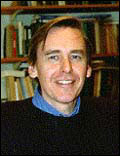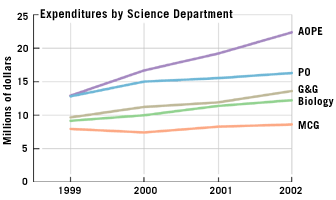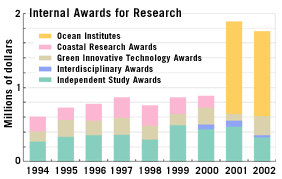
|
 |
Research > Report from the Executive Vice President and Director of Research
Report from the Executive Vice President and Director of Research

Dr. James Luyten
|
 |
The Woods Hole Oceanographic Institution had an excellent year in
2002, both scientifically and in preparing for physical improvements to our campus.
Federally sponsored research, not including marine operations, increased 30 percent from 1999 to 2002 inclusive, and total sponsored research, which includes subcontracts and nongovernment funds, increased 41 percent, with 9 percent of that growth in 2002. This growth reflects modest increases in federal agency budgets, an increase in proposals submitted as well as funding success rate, and our overall success in fundraising. All our science departments shared in this growth over the past several years.
 |

|
Success of Institutes
The four Ocean Institutes completed their second full year of activities in 2002. The Ocean Institutes were introduced to provide a focus and stimulus for interdisciplinary research and to communicate the results of our scientific research to the influential public. Each Institute developed specific research areas and themes (see Ocean Institutes). In 2002 the Institutes awarded 19 grants comprising $1.2 million in research support, bringing research support administered through internal competitions to nearly $2 million per year (graph above right). These funds underwrite higher risk science and jump-start programs to better attract federal support. In addition, the Ocean Institutes provided fellowships, postdocs and other activities, bringing their total funding to $1.89 million.
The Institutes have also developed a suite of communications tools, including Web sites, brochures, and Ocean Forums on key scientific issues related to their themes. In 2002, the Ocean and Climate Change Institute hosted the first Ocean Forum, focused on abrupt climate change and supported by the Comer Science and Education Foundation. Four visiting scientists, who are experts in different aspects of abrupt climate change, presented seminars and collaborated with WHOI scientists over the summer. In the fall they participated in two days of discussion with WHOI researchers, trustees, and corporation members to frame next steps for addressing scientific issues related to the ocean’s role in abrupt climate change. The Forum resulted in a comprehensive research program and strategies to examine policy implications
(see The Ocean Forum on Abrupt Climate Change). Funding from the Comer Foundation will provide key support for initiating this program.

|
Campus Planning
For the past two years, we have developed a master plan that articulates a coherent vision for the Quissett Campus. It includes additional and upgraded laboratory space and other improvements that enable our advancement of knowledge. The Biology and Marine Chemistry and Geochemistry departments, now overcrowded in the Redfield and Fye laboratories, have the most critical needs. The first phase of the master plan was a ring road, which connects all the buildings on the Quissett Campus and forms an interior pedestrian core. The ring road was completed in November 2002.
Phase two of the plan calls for two new laboratories, additional parking, and upgrades to the energy plant and wastewater treatment facilities. Schematics have been completed, and the design development stage is scheduled for completion in summer 2003. Provided regulatory approval and construction proceed as planned, we anticipate occupancy by the end of 2005.
Expansion of our science facilities demands that we further formalize our approach to managing our physical plant. Following a fire in October
in the Clark Laboratory, we reviewed our safety procedures and are implementing a more aggressive approach to further minimize the risk of such an event. The Clark fire caused no injuries and minimal fire damage, but there was extensive smoke damage, compounded by the sensitive nature of many instruments and facilities in the laboratory. We immediately resettled the two dozen affected investigators in temporary work spaces, and began the cleanup, which includes replacement or repair of equipment. We expect recovery to be complete by summer 2003.
Challenges
Our greatest challenge in 2002 came from outside the scientific community, and has far-reaching effects on all of ocean science.
The safety of exploring the ocean by emitting sound under water-as fundamental to oceanography as radar is to aviation-has become an increasingly contentious subject. Acoustical studies in the oceans have drawn scrutiny by environmental activists, who exploit ambiguities and inconsistencies in regulations and jurisdictional coverage concerning the effect of emitting sound on marine animals. Today there appears to be no definitive scientific basis for determining the potential impact of using sound in the ocean that can survive challenges in the courts. As a result, scientists at WHOI and other research institutions have had their work delayed. Ironically, investigations that seek to understand the effect of sound on marine mammals have been postponed. The Institution is working with other research centers, environmental organizations, and funding and regulatory agencies to develop a research plan to address fundamental questions that could form a rational basis for the necessary regulation of sound in the ocean.
Another challenge for us is the evolving nature of our funding. The end of the Cold War brought a welcome relaxation of international tension, but also prompted a steady decline of oceanographic research sponsored by the Office of Naval Research. This loss of support has been most acute in two areas:
- Instrument development, which often requires up to 10 years of sustained effort and support to progress from conception to prototype to useful instrument;
- Process studies at sea, which are risky and require a concentrated effort of many investigators over several years of planning, work at sea and analysis.
Fortunately, we have secured alternative sources of support for both instrument development and process studies at sea. The G. Unger Vetlesen Foundation, for example, has provided support to the Ocean and Climate Change Institute to initiate the Station W program, a long-term observatory stretching 150 kilometers (93 miles) from southeast of Cape Cod to Bermuda. Station W was developed by WHOI for monitoring changes in the thermohaline circulation, known as the Global Conveyer. This circulation is believed to be a critical element in how the ocean affects climate. Vetlesen support provided proof of concept for the Station W work, which helped us leverage further funding from the National Science Foundation. In addition, the Grayce B. Kerr Fund has provided critical support for the WHOI glider program, using an instrument that can provide autonomous ocean sampling over extensive areas.
It is clear that the success of our instrument development and long-term observational studies will depend on our ability to enlist private support and to leverage our work to attract continued funding from both private and government sources.
By the end of 2002, we were well positioned for the year ahead. We have strong and growing support at the federal level, solid commitment from foundations and private donors, and renewal of infrastructure that will enable our investigators to work more effectively. In concert with our oceanographic colleagues and other stakeholders, we are pursuing a constructive discussion and science plan to address the issue of ocean noise. If we can satisfactorily resolve this issue, we will help improve both the quality of life for marine animals and the quality of marine science overall.
—James R. Luyten, Executive Vice President and Director of Research
|
|
